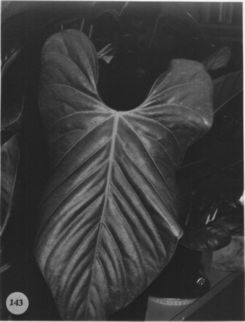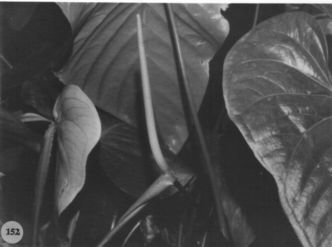




Anthurium pluricostatum Croat & Baker,
Brenesia 16 (Supl. I): 68. 1979.TTYPE: Costa Rica. Lim—n: ca. 1 mile NE ofBribri, ca. 40 miles SW of Lim—n (on coastal road); sleep ravine above Río Catarata, elev. 50-100 m, Croat 43243 (MO 2584480-81, holotype; CR, F, K, US, isotypes; Live at MO).
Terrestrial; stem 2.5-3 cm diam., to 23 cm long; leaf scars conspicuous, ca. 2.5 cm diam.; roots greenish, ca. 4 mm diam., moderately numerous and long, descending; cataphylls moderately thin, 6-12 cm long, acute to acuminate at apex, soon turning brown and weathering into a dense mass of persistent, coarse fibers.
LEAVES with petioles erect, 26-68 cm long, 6-8 mm diam., subtercte, narrowly flattened to weakly and obscurely sulcate adaxially, almost smooth to characteristically several-ribbed or -striatc; genicu-lum 1.2-1.7 cm long; blades narrowly ovate, moderately thin, acuminate at apex, deeply lobed at base, 40-68 cm long, 20-38 cm wide, broadest near the point of petiole attachment, the margins broadly convex; anterior lobe 32-52 cm long, posterior lobes 10-19 cm long, directed downward or inward; the sinus spathulate, obtuse to rounded at apex; upper and lower surfaces semiglossy; midrib obtusely raised at base above, becoming acutely raised and then diminishing toward apex, prominently raised below; basal veins 3-6 pairs, 3 or 4 of them coalesced 3-4 cm, prominently raised above and below; the posterior rib thick, naked, almost straight, the outer margin flat or weakly rolled upward; primary lateral veins 6-9 per side, departing midrib at 30°-45° angle, almost straight to collective vein, raised near midrib but sunken towards apex above, raised below; interprimary veins usually few, scarcely raised above, flat below; secondary veins weakly sunken above, darker than surface and flat below: collective vein arising from the uppermost basal vein, 3-5 mm from margin, slightly sunken above, slightly raised and darker below.
INFLORESCENCE erect-spreading,equalling or much shorter than the leaves; peduncle 17-43 cm long, 4-5 mm diam., terete to obscurely angular, sometimes heavily suffused with dark purple, 0.33-0.75 limes as long as petioles; spathe subcoriaceous, pale purple-violet or green slightly suffused throughout with purplish-violet, especially on the inner surface (B & K Red-purple 7/7.5), oblong-lanceolate, 13-18.5 cm long, 2-3.7 cm wide, broadest in lower quarter, gradually long acuminate at apex, rounded to obtuse at base, stiffly spreading, sometimes twisting, inserted at 50°-70° angle on peduncle; stipe ca. 9 mm long in front and 3 mm long in back, ca. 6 mm diam.; spadix pale lavender or green tinged with pale lavender (B & K Red-purple 8/10), yellowish-green near the tip or sometimes pale reddish-purple throughout (B & K Red-purple 3/5), 8.5-14.5 cm long, 7-9 mm diam. at base, 3-4 mm diam. at apex; flowers rhombic to weakly 4-lobed, 2.6-3.5 mm long, 2.4-3.6 mm wide, the sides straight to smoothly sigmoid, rarely jaggedly sigmoid; 7-9 flowers visible in the principal spiral, (8)10-15 flowers visible in alternate spiral; tcpals semiglossy, papillate, with a few droplets when anthers arc opening, the lateral tepals 1.3-1.8 mm wide, 3-5-sided, the inner margin straight or nearly so; pistils pale green becoming salmon-lavender (as lepals) with purplish dots, slightly mounded and weakly exserted above the tepals; stigma linear, 0.6-0.8 mm long, a pale, darker-edged slit, exuding droplets about 1 week before first stamens emerge, the nectar persisting even after all stamens are open; stamens emerging rapidly from the base, the lateral stamens emerging throughout before the alternate stamens begin to emerge at base, held just above the tepals in a circular cluster ca. 1.3 mm diam. (or sometimes only half emergent with the exposed part ephemeral); anthers white, 0.5-0.6 mm long, 0.9-1 mm wide, peeping out and opening while still small or the thecae standing on end, opening vertically and disintegrating when touched; thecae obovoid, slightly divaricate; pollen white.
INFRUCTESCENCE with purplish berries, acute at apex. Figs. 143 and 152.
The species is known from Costa Rica, and in Panama in Chiriquí Province
on the Burica Península. It is certainly to be expected in Bocas del Toro
Province as well. It occurs in a wide variety of life zones in Costa Rica,
ranging from premontane wet transition forest to premontane wet and tropical
wet forest at elevations from near sea level lo 1,000 m on both the Pacific
and Atlantic slopes.
Anthurium pluricostatum is a member of section Belolonchium
and is characterized by its terrestrial habit, subterete petiole with 7-10
low ridges, and spadix that is lavender lo reddish-purple or green tinged
with lavender, usually with a discolorous yellowish-green portion near
the apex. The species is also unusual in having flowers with stigmatic
droplets persisting while stamens emerge. Anthurium pluricostatum
is related to A. ochranthum. The latter
species, although occurring in the same altitudinal range and life zones,
has a very different inflorescence, including a bright yellow spadix (at
anthesis), and stamens with pollen being extruded in slender ribbons. Both
A. pluricostatum and A. ochranthum have a consistently terrestrial
habit that is a diagnostic feature for species occurring at medium lo low
elevations (the character being of much less value in cloud forest regions).
Staminal dehisccnce is somewhat variable. Usually the anthers are fully
exserted although the filaments are not exposed. Sometimes (even in the
same population) anthers are only about half emergent and the exposed portion
of the thecae loses its form when the pollen matures. The species displays
an unusual pollination possibility since the stigmas produce copious droplets
slightly before the stamens emerge, the droplets persisting until all anthers
arc open. Thus the species is only weakly protogynous and might best be
considered homogamous. The behavior presents a clear possibility for self
fertilization.
 |
 |
Map of Mesoamerican specimens with coordinates
Costa Rica Heredia: 100 m, 10.27N 84.05W, 1 Oct. 1987, Thomas B. Croat
68377 (MO).
Costa Rica Lim—n: 70-150 m, 9.30.10N 82.57.50W, 1 July 1989, Abelardo
Chacón 64 (MO).
Costa Rica Lim—n: 90-200 m, 09.40.30N 83.02.00W, 31 July 1985, Michael
H. Grayum & Barry Hammel 5765 (MO).
Costa Rica Lim—n: 150 m, 09.39N 83.02W, 1 August 1985, Michael H. Grayum,
B. Hammel, L. Bermúdez & R. Acosta 5796 (MO).
Costa Rica Lim—n: 5 m, 09.38N 82.41W, 3 Nov 1984, Michael Grayum &
Pam Sleeper 4355 (MO).
Costa Rica Lim—n: 20-60 m, 09.38N 82.43W, 6 Nov 1984, Michael Grayum,
Mel Baker & Pam Sleeper 4416 (MO).
Costa Rica Lim—n: 240 m, 10.03N 83.26W, 2 September 1988, Michael Grayum,
Gerardo Herrera & Rafael Robles 8669 (MO).
Costa Rica Lim—n: Quebrada Amubri, 70-150 m, 09.30.10N 82.57.50W, 1
July 1989, Chacon, A. 64 (CR, MO).
Costa Rica Lim—n: Río Catarata, 50-100 m,, 11 Aug 1977, Thomas
B. Croat 43206 (MO).
Costa Rica Lim—n: Río Catarata, 50-100 m,, 12 Aug 1977, Thomas
B. Croat 43243 (MO).
Costa Rica Lim—n: 40 m, 10.25N 83.34W, 3 November 1987, Rafael Robles
1211 (MO).
Costa Rica Lim—n: 40 m, 10.25N 83.34W, 4 November 1987, Rafael Robles
1229 (MO).
Costa Rica Puntarenas: 160 m, 8.45N 83.18W, 2 March 1985, T.B. Croat
& M.H. Grayum 59735 (MO).
Costa Rica Puntarenas: 60 m, 8.34N 83.25W, 4 March 1985, T.B. Croat
& M.H. Grayum 59813 (MO).
Costa Rica Puntarenas: 250-540 m, 8.42N 83.31W, 4 March 1985, T.B.
Croat & M.H. Grayum 59841 (MO).
Costa Rica Puntarenas: 100 m, 8.41N 83.12W, 6 March 1985, T.B. Croat
& M.H. Grayum 59905 (MO).
Costa Rica Puntarenas: 30 m, 8.11N 83.12W, 15 Sept. 1987, Thomas B.
Croat 67617 (MO).
Costa Rica Puntarenas: 10 m, 8.41.40N 83.28.40W, 14 August 1990, Helen
Kennedy 4560 (CR, MO).
Costa Rica Puntarenas: 50 m, 08.42.01N 83.30.48W, 11 September 1996,
Thomas B. Croat & Dylan Hannon 79234 .
Costa Rica Puntarenas: 200-300 m, 08.42.00N 83.12.30W, 12 September
1996, Thomas B. Croat & Dylan Hannon 79278 (INB, MO).
Costa Rica San José: 990-1100 m, 09.18.24N 83.46.11W, 9 September 1996,
Thomas B. Croat & Dylan Hannon 79106 (MO).
Nicaragua Zelaya: 10-20 m, 11.32N 83.48W, 07 Feb. 1982, Moreno, P.
and Sandino, J. 15110 (MO).
Nicaragua Zelaya: 10 m, 11.34N 84.01W, 10 noviembre 1981, P.P.Moreno
y J.C.Sandino 12744 (MO).
Nicaragua Zelaya: 60 m, 11.32N 84.01W, 11 noviembre 1981, P.P.Moreno
& J.C.Sandino 12868 (MO).
Nicaragua Zelaya: 30 m, 11.32N 84.05W, 14 noviembre 1981, P.P.Moreno
& J.C.Sandino 13118 (MO).
Panama Bocas del Toro: 310 m, 8.45N 82.10W, 9 March 1985, T.B. Croat
& M.H. Grayum 60146 (MO).
Panama Bocas del Toro: 590 m, 8.46N 82.14W, 10 March 1985, T.B. Croat
& M.H. Grayum 60199 (MO).
Panama Bocas del Toro: 1200 m, 8.44N 82.17W, 11 March 198, T.B. Croat
& M.H. Grayum 60349 (MO).
Panama Bocas del Toro: 10 m, 08.45N 81.20W, 6 August 1987, Gordon McPherson
11399 (MO).
Panama Bocas del Toro: 5 m, 9.5N 81.35W, 8 August 1987, Gordon McPherson
11427 (MO)
Panama CoclŽ: El Valle de Antón, 400-700 m,, 31 Jan 1935, Hunter
& Allen 341 (G).
Panama CoclŽ: 680-770 m, 08.39N 80.36W, 25 March 1993, Thomas B. Croat
74846 (MO).
Panama CoclŽ: 850-950 m, 8.37N 80.08W, 14 July 1987, Thomas B. Croat
67300 (MO).
Panama CoclŽ: 850 m, 8.39N 80.36W, 13 Sept. 1987, Thomas B. Croat 67581
(MO).
Panama Panamá: 900 m, 08.41N 79.54W, 21 January 1985, Henk van der
Werff & J. Herrera 6192 (MO).
Panama Panamá: 800 m, 8.40N 79.50W, 21 March 1985, Gordon McPherson
6907 (MO).
Panama San Blas: 0 m,, 23 March 1985, W.G. D'Arcy & G. McPherson
16118 (MO).